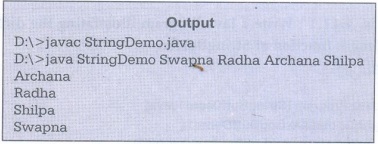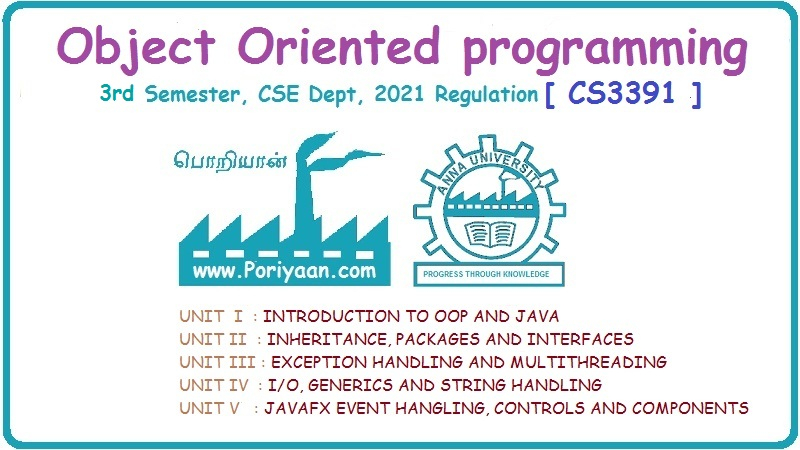Object Oriented Programming: Unit IV: I/O, Generics, String Handling
String Methods
with Example Java Programs
We can find the length of a given string using the method length(). Following program shows the use of length() method for strings
String Methods
We can
find the length of a given string using the method length(). Following program
shows the use of length() method for strings
Java Program [Str_length Demo.Java]
class Str_lengthDemo
{
public
static void main(String[] args).
{
char
str[]={'P', 'R','O', 'G', 'R', 'A', 'M'};
String
S=new String(str);
System.out.println("The
string S is "+S);
System.out.println("The
length of string is "+S.length());
System.out.print("The
string in character array is ");
for(int
i=0;i<S.length();i++)
System.out.print(str[i]);
}
}
Output
D:\>javac
Str_length Demo.java
D:\>java
Str_lengthDemo
The
string S is PROGRAM
The
length of string is 7
The
string in character array is PROGRAM
String in reverse direction
There is
no direct method for reversing the string but we can display it in reverse
direction.
Following
is the Java program for the same
Java Program[Str_reverse.java]
*********************
Printing
the String in reverse order
*********************
class
Str_reverse
{
public
static void main(String[] args)
{
char
str[] = {'S','T', 'R','I', 'N','G'};
String
S=new String(str);
System.out.println("The
string S is "+S);
System.out.print("The
string written in Reverse order ");
for(int
i=S.length()-1;i>=0;i--)
System.out.print(str[i]);
}
}
Output
The
string S is STRING
The
string written in Reverse order GNIRTS
Character Extraction
• As we
know that the string is a collection of characters. String class provides the
facility to extract the character from the String object. There is a method
called charAt(index) with the help of which we can extract the character
denoted by some index in the array.
For example:
String
fruit=new String("mango");
char ch;
ch=fruit.charAt(2);
System.out.println(ch);
• The
output of above code fragment will be n because at the index position 2 of
string object fruit the character n is present.
String Comparison
Sometimes
we need to know whether two strings are equal or not. We use method equals()
for that purpose. This method is of Boolean type. That is, if two strings are
equal then it returns true otherwise it returns false.
The
syntax is
Boolean
equals(String Str);
Let us
see one illustrative program -
Java Program [StringCompare Demo.Java]
class
StringCompareDemo
{
public
static void main(String[] args)
{
String
str1= new String("INDIA");
String
str2= new String("india");
if(str1.equals(str2)==
true)
System.out.println("\n
The two strings are equal");
else
System.out.println("\n
The two strings are not equal");
}
}
Output
D:\>javac
StringCompare Demo.java
D:\>java
StringCompareDemo
The two
strings are not equal
The
above program will generate the message "The two strings are not
equal" if str1 and str2 are not equal but if we write same strl and str2
then naturally the output will be "The two strings are equal". This
string comparison is case sensitive. But if we want to compare the two strings
without caring for their case differences then we can use the method
equalsIgnoreCase().
Searching for the Substring
We can
look for the desired substring from the given string using a method
substring(). The syntax of method substring() is as follows -
String
substring(int start_index, int end_index)
Java Program [Substring Demo.Java]
class
SubstringDemo
{
public
static void main(String[] args)
{
String
str1= new String("I love my country very much");
System.out.println("\n
One substring from the given sentence is:"+str1.substring(2,6));
System.out.println("\n
And another substring is:"+str1.substring(18));
}
}
Output
D:\>javac
SubstringDemo.java
D:\>java
SubstringDemo
One
substring from the given sentence is:love And another substring is:very much
Replacing the Character from String
We can
replace the character by some desired character. For example
Java Program [replace Demo.java]
class
replaceDemo
{
public
static void main(String[] args)
{
String
str=new String("Nisha is Indian ");
String
s= str.replace('i','a');
System.out.println(s);
}
}
Output
D:\>javac
replace Demo.java
D:\>java
replace Demo
Nasha as
Indaan
Upper and Lower Case
We can
convert the given string to either upper case or lower case using the methods
toUpperCase() and toLowerCase(). Following program demonstrates the handling of
the case of the string -
Java Program [CaseDemo.Java]
class
caseDemo
{
public
static void main(String[] args)
{
String
str=new String("Nisha is Indian ");
System.out.println("\n
The original string is: "+str);
String
str_upper= str.toUpperCase();
System.out.println("\n
The Upper case string is: "+str_upper);
String
str_lower= str.toLowerCase();
System.out.println("\n
The Lower case string is: "+str_lower);
}
}
Output
D:\>javac
caseDemo.java
D:\>java
caseDemo
The
original string is: Nisha is Indian
The
Upper case string is: NISHA IS INDIAN
The
Lower case string is: nisha is Indian
Concatenating Strings
We can
concatenate two strings using + operator which is illustrated by following code
-
Java Program [Test.Java]
class
Test
public
static void main(String[] args)
{
String
fruit new String("mango");
System.out.println("I
like "+fruit +" very much");
}
}
Output
I like
mango very much
We can
make use of a method concat() for concatenating two strings. The above program
is slightly modified for the use of concat()-ne
Java Program
class
Test
{
public
static void main(String[] args)
{
String
str=new String("I like ");
String
fruit=new String("mango very much");
System.out.println(str.concat(fruit));
}
}
Output
I like
mango very much
Ex. 4.10.1: Write a Java Program
that collects the input as a decimal number of integer type and converts it
into a String of equivalent hexadecimal number.
Sol. :
import
java.io.*;
class
DecToHex
{
public
static void main(String[] args) throws IOException
{
//Following
3 statements is required to read the input through keyboard BufferedReader
br=new BufferedReader (new InputStreamReader(System.in));
System.out.print("Enter
a decimal number: ");
int num=
Integer.parseInt(br.readLine());
int rem;
String
str=""";
//array
storing the digits (as characters) in a hexadecimal number system char digits[]
= {'0', '1', '2', '3', '4','5', '6', '7', '8', '9', 'A', 'B', 'C', 'D', 'E',
'F'};
while(num>0)//divide
until num is 0
{
rem=num%16;
//finding remainder by dividing the number by 16
str=digits[rem]
+ str; //adding the remainder to the result
num=num/16;
}
System.out.println("Output
"+str);
}
}
Output
Enter a
decimal number: 10
Output =
A
Ex. 4.10.2: Write a Java Program
that arranges the given set of strings in alphabetical order. Supply the
strings through the command line.
Sol.:
class String
Demo
{
public
static void main(String[] args)
{
String
temp;
int n = args.length;
int
i,j,c;
for
(i=0; i<n-1; i++)
{
for
(j=i+1; j<n; j++)
{
c=
args[i].compareTo(args[j]);
if (c
>0)
{
temp =
args[i];
args[i]
= args[j];
args[j] =
temp;
}
}
}
for
(i=0; i<n;i++)
{
System.out.println(args[i]);
}
}
}
Output

Object Oriented Programming: Unit IV: I/O, Generics, String Handling : Tag: : with Example Java Programs - String Methods
Related Topics
Related Subjects
Object Oriented Programming
CS3391 3rd Semester CSE Dept | 2021 Regulation | 3rd Semester CSE Dept 2021 Regulation
